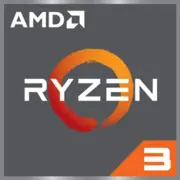AMD Ryzen 3 5300U

AMD Ryzen 3 5300U: A Budget Processor for Everyday Tasks and More
April 2025
Architecture and Process Technology: Zen 2 in a Compact Package
The AMD Ryzen 3 5300U processor, released in early 2021, remains a popular choice for budget laptops as of 2025. It is built on the Zen 2 microarchitecture and manufactured using 7nm TSMC FinFET technology, striking a balance between performance and energy efficiency.
- Cores and Threads: 4 cores and 8 threads thanks to SMT (Simultaneous Multithreading) technology.
- Frequencies: Base frequency is 2.6 GHz, with a maximum in Turbo Boost mode of up to 3.8 GHz.
- Cache Memory: L3 - 4 MB (shared across all cores), L2 - 2 MB (512 KB per core).
- Integrated Graphics: AMD Radeon Graphics (Vega 6) with 6 compute units (CU), operating at up to 1500 MHz.
Although Zen 2 lags behind the newer Zen 4 in multi-threaded workloads, it is sufficient for light tasks and office work. The Vega 6 graphics, while lacking support for technologies like FSR 3, can handle HD gaming and video content acceleration.
Power Consumption and TDP: 15W for Mobility
The processor's TDP is rated at 15W, making it ideal for ultrabooks and thin laptops. Thanks to the 7nm process, the chip efficiently manages power consumption:
- In idle mode, consumption drops to 3-5W.
- Under load (e.g., video rendering), it can reach up to 25W with brief turbo boosts.
Cooling systems in laptops with the Ryzen 3 5300U are typically passive or equipped with compact fans, minimizing noise. For example, in the Acer Swift 3, the processor does not exceed 75°C even under load.
Performance: Speed for Office Tasks and Light Gaming
Office Tasks and Multimedia
- Office Applications: In Microsoft Office, browsers with 10+ tabs, and Zoom, the processor operates without delays. PCMark 10 benchmark scores around 4500 points—a level sufficient for multitasking.
- Video Editing: Rendering a 1080p video in Adobe Premiere Pro takes about 12 minutes (compared to around 8 minutes for the Intel Core i5-1240P).
Gaming
The integrated Vega 6 graphics demonstrate the following results in games (Low/Medium settings, 720p-1080p):
- CS:2 — 45-60 FPS;
- Fortnite — 35-50 FPS;
- GTA V — 40-55 FPS.
For comfortable gaming in Apex Legends or Cyberpunk 2077, an external graphics card will be required, but there is enough capability for indie titles and retro games.
Turbo Boost Mode
When turbo mode is activated (up to 3.8 GHz), the processor briefly increases performance by 20-30%, which is useful for “bursts” in the browser or launching heavy applications. However, in budget laptops, this mode is often limited due to weak cooling systems.
Usage Scenarios: Who is the Ryzen 3 5300U Suitable For?
1. Students and Office Workers — for document work, online courses, and Zoom meetings.
2. Users who value battery life — laptops with this processor are often equipped with 40-50 Wh batteries (e.g., Lenovo IdeaPad 5).
3. Casual Gamers — for Minecraft, Dota 2, or retro console emulators.
Not recommended for:
- Professional 4K video editing;
- Heavy gaming without an external graphics card;
- Working with AI models or 3D rendering.
Battery Life: Up to 10 Hours in Reading Mode
Thanks to the 15W TDP and AMD's Power Efficiency optimizations, laptops with the Ryzen 3 5300U show:
- 8-10 hours for text work and browsing (brightness at 150 nits);
- 5-6 hours for watching YouTube;
- 3-4 hours under load (gaming, editing).
Energy-saving technologies:
- Precision Boost 2 — dynamic frequency management;
- Adaptive Power Management — reducing voltage to the cores in idle.
Comparison with Competitors: The Budget Segment of 2025
AMD Ryzen 3 7420U (Zen 3, 4 Cores)
- 15-20% faster in single-threaded tasks;
- Laptop prices: starting from $600 (compared to $500 for models with the 5300U).
Intel Core i3-1315U (10-core Hybrid Chip)
- Better in single-thread tests (Geekbench 6 Single Core — ~1350);
- Weaker in multi-threading (Geekbench 6 Multi Core — ~3200);
- Higher power consumption (up to 20W).
Apple M1 (in used MacBook Airs)
- 2-3 times higher performance;
- Limited compatibility with Windows software;
- Prices starting at $700 (new devices are no longer available).
Pros and Cons of Ryzen 3 5300U
Strengths:
- Low price of laptops (from $500);
- Good energy efficiency;
- Support for multi-threading.
Weaknesses:
- Outdated Zen 2 architecture;
- No support for PCIe 4.0;
- Limited graphics capabilities for modern games.
Recommendations for Laptop Selection
1. Type of Device: Ultrabooks (Acer Swift 3) or budget all-rounders (HP Pavilion Aero).
2. Screen: IPS matrix with FHD resolution. Avoid TN screens!
3. RAM: At least 8 GB (preferably 16 GB for multitasking).
4. Storage: 512 GB SSD (NVMe preferred).
5. Battery: From 45 Wh for 6+ hours of autonomy.
Examples of 2025 models:
- Lenovo IdeaPad 5 15ALC: $550, 16 GB RAM, 512 GB SSD;
- ASUS Vivobook 15: $520, 8 GB RAM, FHD screen.
Final Conclusion
The AMD Ryzen 3 5300U in 2025 is a choice for those looking for an affordable laptop for study, work, and light entertainment. Its key advantages include:
- Affordable price;
- Long battery life;
- Sufficient performance for everyday tasks.
It falls short against newer processors in resource-intensive scenarios, but remains one of the best options in the sub-$600 segment. If you don't need AAA gaming or professional software, the Ryzen 3 5300U is still relevant.
Basic
CPU Specifications
Memory Specifications
GPU Specifications
Miscellaneous
Benchmarks
Compared to Other CPU
Share in social media
Or Link To Us
<a href="https://cputronic.com/en/cpu/amd-ryzen-3-5300u" target="_blank">AMD Ryzen 3 5300U</a>